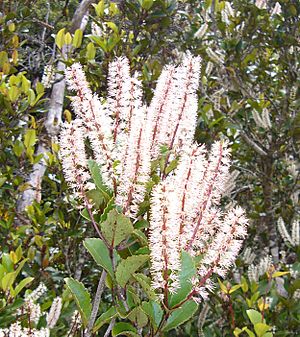Kamahi facts for kids
Quick facts for kids Kāmahi |
|
|---|---|
 |
|
| Scientific classification | |
| Genus: |
Weinmannia
|
| Species: |
racemosa
|
The kāmahi (scientific name: Weinmannia racemosa) is a special evergreen tree found in New Zealand. It can be a small bush or a medium-sized tree. Kāmahi belongs to the Cunoniaceae plant family. It's the most common forest tree in New Zealand, growing in many different places. You can find it from the middle of the North Island all the way south to Stewart Island.
Contents
What is the Kāmahi Tree?
Kāmahi trees have small flowers that grow in clusters called racemes. These flowers can be pink or white and appear from July to January. After the flowers, small fruits grow. These fruits are like tiny seed pods, called capsules, and are about 4 to 6 millimeters long. They ripen between October and May.
Where Kāmahi Trees Grow
Kāmahi trees often grow alongside other broadleaf trees. Sometimes, they are a "pioneer species". This means they are one of the first trees to grow in a new or disturbed area. Over time, other trees like southern beeches (Nothofagus species) or podocarps might grow and take their place.
Kāmahi trees can grow very tall. In the Catlins area of the south-eastern South Island, they can reach 25 meters or even more. In forests west of the Southern Alps, kāmahi often grows together with southern rātā (Metrosideros umbellata) and black beech (N. solandri).
Related Trees
There is a tree closely related to kāmahi called tōwai or tawhero (W. silvicola). This tree grows in the North Island, but only north of latitude 38°S. In those northern areas, tōwai takes the place of kāmahi.
How People Use Kāmahi
The bark of the kāmahi tree is very useful. It contains a lot of tannin, which is a natural substance. About 13% of the bark is tannin. In the past, this bark was sent to other countries to be used for tanning. Tanning is a process that turns animal skins into leather.
Traditional Māori Uses
The Māori traditionally used the inner bark of the kāmahi tree. They used it as a laxative, which is a type of medicine that helps with digestion.
Kāmahi Wood
Even though kāmahi trees are very common, their wood is not used much. This is because the wood tends to bend or crack easily.


